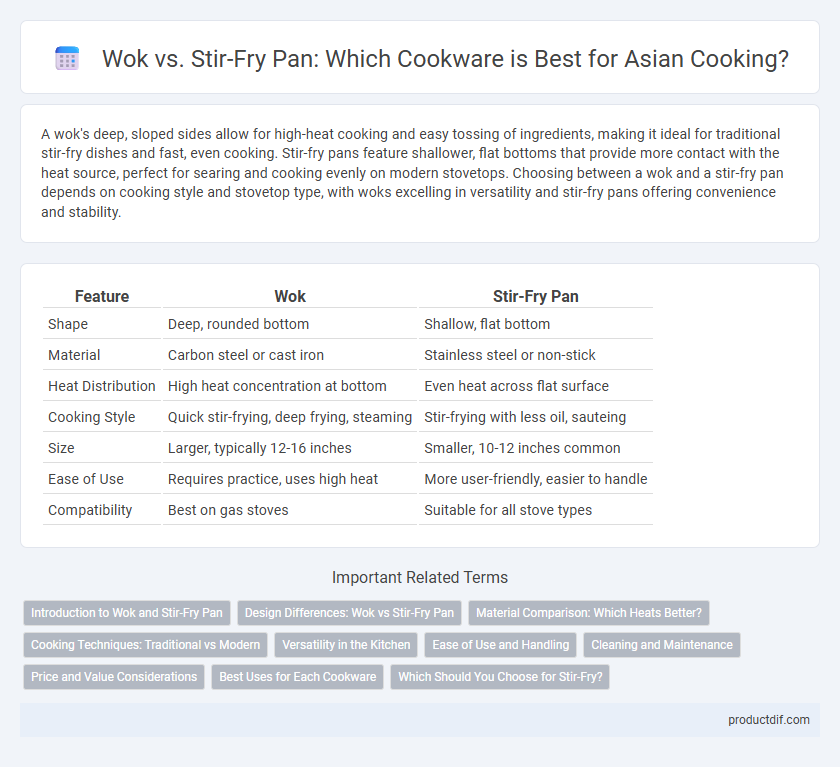A wok's deep, sloped sides allow for high-heat cooking and easy tossing of ingredients, making it ideal for traditional stir-fry dishes and fast, even cooking. Stir-fry pans feature shallower, flat bottoms that provide more contact with the heat source, perfect for searing and cooking evenly on modern stovetops. Choosing between a wok and a stir-fry pan depends on cooking style and stovetop type, with woks excelling in versatility and stir-fry pans offering convenience and stability.
Table of Comparison
| Feature | Wok | Stir-Fry Pan |
|---|---|---|
| Shape | Deep, rounded bottom | Shallow, flat bottom |
| Material | Carbon steel or cast iron | Stainless steel or non-stick |
| Heat Distribution | High heat concentration at bottom | Even heat across flat surface |
| Cooking Style | Quick stir-frying, deep frying, steaming | Stir-frying with less oil, sauteing |
| Size | Larger, typically 12-16 inches | Smaller, 10-12 inches common |
| Ease of Use | Requires practice, uses high heat | More user-friendly, easier to handle |
| Compatibility | Best on gas stoves | Suitable for all stove types |
Introduction to Wok and Stir-Fry Pan
A wok is a versatile, round-bottomed cooking vessel traditionally used in Asian cuisine, ideal for high-heat stir-frying, deep-frying, and steaming. Stir-fry pans typically feature a flatter base with gently sloping sides, designed to accommodate Western stovetops while still enabling quick, even cooking at high temperatures. Both cookware types enhance rapid cooking techniques but differ in shape and heat distribution, influencing their specific culinary applications.
Design Differences: Wok vs Stir-Fry Pan
Woks feature a deep, rounded bowl design that allows for intense heat concentration and easy tossing of ingredients, ideal for high-heat stir-frying and steaming. Stir-fry pans have a flatter, wide base with slightly sloped sides, providing more surface contact for even heat distribution and convenient use with a spatula. The wok's curved shape supports rapid cooking with minimal oil, while the stir-fry pan balances versatility and ease of use on standard stovetops.
Material Comparison: Which Heats Better?
Carbon steel woks heat faster and retain heat more efficiently than stainless steel stir-fry pans, making them ideal for high-heat cooking and quick searing. Cast iron stir-fry pans offer excellent heat retention but take longer to preheat compared to carbon steel woks. Aluminum stir-fry pans heat quickly but lack the heat retention properties of carbon steel and cast iron, affecting cooking consistency.
Cooking Techniques: Traditional vs Modern
Woks feature a rounded bottom and high, sloping sides designed for traditional stir-frying with quick, high-heat tossing that evenly cooks ingredients while retaining texture and flavor. Stir-fry pans typically have a flat bottom and lower sides, adapted for modern stovetops, offering stable contact with heat sources and enabling easier stirring and searing of ingredients. Traditional wok techniques emphasize rapid airflow and continuous tossing, whereas modern stir-fry pans allow for versatile cooking such as sauteing and frying with controlled heat distribution.
Versatility in the Kitchen
A wok's deep, rounded shape excels for versatile cooking methods such as stir-frying, steaming, and deep-frying, making it ideal for high-heat, quick-cooking techniques common in Asian cuisine. Stir-fry pans feature a flatter base and sloped sides, providing better stability and even heat distribution on flat burners, suitable for sauteing, searing, and pan-frying a variety of dishes. Choosing between a wok and a stir-fry pan depends on the stove type and cooking style, with woks favoring intense, rapid heat and stir-fry pans offering versatility and compatibility with Western cooking methods.
Ease of Use and Handling
Woks feature a rounded bottom and long handle, making them ideal for high-heat, quick cooking but can be challenging to stabilize on flat stovetops and require skillful tossing techniques. Stir-fry pans have a flat bottom and slightly curved sides, providing easier handling and compatibility with all stovetops while allowing straightforward stirring and flipping motions. For beginners or those seeking convenience, a stir-fry pan offers superior ease of use compared to the traditional wok.
Cleaning and Maintenance
Woks typically feature a rounded bottom that can make thorough cleaning challenging, especially when food particles get trapped in the curved surface, requiring careful scrubbing and seasoning to maintain a non-stick patina. Stir-fry pans, with their flatter bases and often enamel or non-stick coatings, offer easier cleaning and are less prone to rust, making maintenance more straightforward. Regular seasoning is essential for carbon steel woks to prevent rust, whereas stir-fry pans generally require less upkeep due to their protective coatings.
Price and Value Considerations
Woks generally offer a more affordable option compared to stir-fry pans, making them ideal for budget-conscious cooks seeking versatility. Stir-fry pans, often constructed with heavier materials and non-stick coatings, provide enhanced durability and ease of use, justifying their higher price point. Evaluating price against features and longevity helps determine the best value for specific cooking needs.
Best Uses for Each Cookware
Woks excel at high-heat cooking techniques like stir-frying, deep-frying, and steaming, making them ideal for Asian-inspired dishes due to their rounded shape and sloped sides that facilitate tossing ingredients quickly. Stir-fry pans, with their flatter base and slightly flared sides, provide better contact with the heat source and are perfect for searing and evenly cooking a variety of dishes, including vegetables, meats, and sauces. Choosing between a wok and a stir-fry pan depends on the cooking method and recipe requirements, with woks suited for rapid, high-heat tossing and stir-fry pans offering stability for more controlled cooking.
Which Should You Choose for Stir-Fry?
A wok offers deep, sloped sides that enable high-heat cooking with ample tossing space, preserving the integrity of ingredients during stir-fry. Stir-fry pans, typically flatter and with straighter sides, provide more surface area for even searing and easier flipping, ideal for smaller quantities. Choosing between a wok and stir-fry pan depends on your cooking style, stove type, and the volume of stir-fry you frequently prepare.
Wok vs Stir-Fry Pan Infographic

 productdif.com
productdif.com